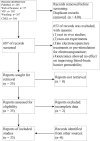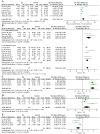Electroacupuncture stimulation enhances the permeability of the blood-brain barrier: A systematic review and meta-analysis of preclinical evidence and possible mechanisms
- PMID: 38536776
- PMCID: PMC10971611
- DOI: 10.1371/journal.pone.0298533
Electroacupuncture stimulation enhances the permeability of the blood-brain barrier: A systematic review and meta-analysis of preclinical evidence and possible mechanisms
Abstract
An important cellular barrier to maintain the stability of the brain's internal and external environment is the blood-brain barrier (BBB). It also prevents harmful substances from entering brain tissue through blood circulation while providing protection for the central nervous system. It should be noted, however, that the intact BBB can be a barrier to the transport of most drugs into the brain via the conventional route of administration, which can prevent them from reaching effective concentrations for the treatment of disorders affecting the central nervous system. Electroacupuncture stimulation has been shown to be effective at opening the BBB in a series of experimental studies. This study systematically analyzes the possibility and mechanism by which electroacupuncture opens the BBB. In PubMed, Web of Science, VIP Database, Wanfang Database, and the Chinese National Knowledge Infrastructure, papers have been published for nearly 22 years aimed at opening the BBB and its associated structures. A comparison of EB content between electroacupuncture and control was selected as the primary outcome. There were also results on vascular endothelial growth factor (VEGF), nerve growth factor (NGF), P-Glycoprotein (P-gp), Matrix Metalloproteinase 9 (MMP-9), and glial fibrillary acidic protein (GFAP). We utilized Review Manager software analysis to analyze correlations between studies with a view to exploring the mechanisms of similarity. Evans Blue infiltration forest plot: pooled effect size of 2.04, 95% CI: 1.21 to 2.87, P < 0.01. These results indicate that electroacupuncture significantly increases EB penetration across the BBB. Most studies have reported that GFAP, MMP-9, and VEGF were upregulated after treatment. P-gp expression decreased as well. Electroacupuncture can open the BBB, and the sparse-dense wave is currently the most effective electroacupuncture frequency for opening the BBB. VEGF plays an important role in opening the BBB. It is also important to regulate the expression of MMP-9 and GFAP and inhibit the expression of P-gp.
Copyright: © 2024 Xu et al. This is an open access article distributed under the terms of the Creative Commons Attribution License, which permits unrestricted use, distribution, and reproduction in any medium, provided the original author and source are credited.
Conflict of interest statement
The authors have declared that no competing interests exist.
Figures







References
-
- Xiong P., Huang X., Ye N., Lu Q., Zhang G., Peng S., et al.. (2022). Cytotoxicity of Metal-Based Nanoparticles: From Mechanisms and Methods of Evaluation to Pathological Manifestations. Advanced science (Weinheim, Baden-Wurttemberg, Germany), 9(16), e2106049. doi: 10.1002/advs.202106049 - DOI - PMC - PubMed
Publication types
MeSH terms
Substances
LinkOut - more resources
Full Text Sources
Miscellaneous

